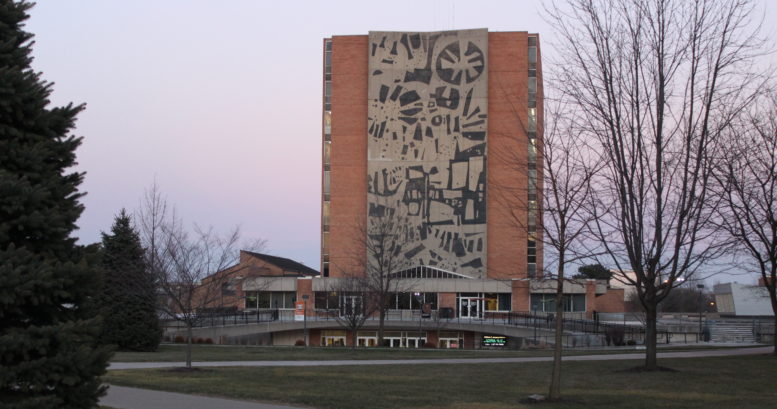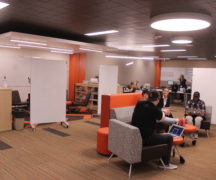By DAVID DUPONT
BG Independent News
A state Third Frontier grant will help Bowling Green State University launch new research, teaching and commercial ideas.
The money comes part of $8.7 million in funding that’s half state money and half matching funds from the institutions. The money was awarded to NextTech, a collaborative organization comprised of BGSU, Mercy Health, ProMedica, and the University of Toledo, which is the Entrepreneurial Service Provider for Northwest Ohio.
Michael Ogawa, BGSU vice president for research and economic engagement, said the university’s share is about $707,000, half from the state, half from BGSU.
That money will help to create the Collab-Lab, a new initiative to help faculty staff, and students work together to create new ideas. The lab will be in the first floor of Jerome Library, across from the elevators. Now there’s a technical support lab and a classroom in the space. That area, said Jerry Schnepp, the lab director, will be gutted to create a 2,000-square foot lab. Work begins May 10 and the lab will open of the start of the fall semester.
The library as the intellectual heart of campus is the right place for the lab, Ogawa said. Though the space itself isn’t open, the initiative is already getting the ideas flowing.
Schnepp said he’s been approached by faculty members who have ideas but need other skills to bring it to fruition. Workshops have been held to bring together faculty members, who have ideas to share, with other colleagues.
One of the matches was someone from Women’s Study who has a store of oral histories with a librarian who had a knowledge of metadata that can be used to make the information in the interviews more accessible.
Schnepp said he hopes the lab draws in people from a wide range of academic areas.
The lab will be intended to get ideas started, not necessarily bring them to fruition. If a product needs further development that work can be done at the University of Toledo’s Launch Pad or Pro Medica’s business incubator.
Together all the partners form an ecosystem for innovation, Schnepp said.
The Collab-Lab is a good fit for BGSU, Ogawa said. BGSU has neither an engineering nor medical school. Those fields typically generate a lot of ideas for technology.
What BGSU offers is “not as natural a link to the business sector,” he said.
“The question is how do we begin to start activities in an entrepreneurial space?
BGSU has strengths education, visual communications technology, data science, and computer science. “That could be our tech base,” he said.
In visiting other institutions with similar facilities, including Harvard, MIT, and Case-Western, they were told “not to get too caught up in the technology,” Schnepp said.
The space will have 3D printers, laser etcher, a 3D scanner, a visual reality station, and a suite of digital art programs. But they were told the fastest way to get ideas out “is when you have fast prototyping material, markers, white boards, Post-It notes, pipe cleaners,” Schnepp said.
With these collaborators can “make very low fidelity prototypes very quickly.”
This kind of activity is also increasingly used in education.
The lab will employ a staff including Schnepp and Kim Fleshman, three graduate students, and a dozen undergraduates.
The students will provide more than tech support. They will be trained in design thinking.
At this point most of those students have been selected from VCT and graphic design in the School of Art, but could come from other disciplines as well.
“People will come into the Collab Lab with a vaguely formed idea,” Ogawa said. The lab staff will help them shape the idea, meet collaborators, and form interdisciplinary teams. The idea is to accelerate that creative process.
There will also be an entrepreneur in residence. If an idea has the potential to be commercialized, the entrepreneur will evaluate it and recommend a next step.
“If there’s a business and it can be commercialized,” Ogawa said, “then it will handed off to partners. … They’d have more sophisticated business acumen.”
Beyond that the collaborators will then seek funding to bring it to market.
But faculty will also be working on ideas related to their research, and developing new ways to teach. “We’re anticipating brand new ideas, not just businesses.”
Schnepp said he expect when students become involved, they will spark more ideas with commercial potential.
Faculty, he said, are focused on research and teaching, as a way of improving how they do their jobs. Students are looking beyond their time on campus toward their futures.


